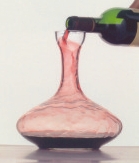|
PORT
Quinta de la Rosa

Quinta de la Rosa, one of the finest
vineyards in the Douro Valley, is situated on the banks of the river
in the 'A' grade port growing area and run by the Bergqvist family who
have been involved in the port trade since 1805.
See our wine
section for the latest ports and wines available.

See our gift department
for a superb selection of decanters, corkscrews and other wine accessories.
|
- Farm Focus -
Why is goats' milk cheese in short supply in the
winter

The greatest demand for goats' cheese is in the winter
months. Unfortunately, it is at this time that goats produce the least
amount of milk. We are often asked why this is the case and why don't
cows' milk cheeses suffer in the same way?
Goats, like all mammals, can only produce milk for
a period after giving birth. In addition, nature and evolution have
increased the chances of them raising their young successfully by giving
birth in the spring when food supplies are plentiful. Goats can only
mate when the female is in season. The period of oestrus lasts for one
to three days, and is repeated again after twenty-one days. This cycle
continues from late September until February.
After giving birth the goat can produce milk for
twenty-two months after which she will need to mate again. Thus, to
ensure a continuous supply of milk throughout the year, a householder
with two goats will mate one and keep the other in milk for twenty-two
months, mating her the following September. The same applies to commercial
herds. Half the goats give birth one year and the other half the next.
This method of breeding ensures milk production throughout
the year but there will still be an abundance of milk in the summer
and autumn when all goats are producing milk, but a shortage in the
winter when half of the goats are gradually drying out ready for kidding.
Some farms have developed ways of easing this problem
by organising goat kidding is another way. One third of the goats are
mated early in the season, in September, so that the kids are born in
early Spring; another third are mated towards the end of the season,
in January, so that the kids are born in late spring; the final third
have lighting installed in their shelters so that during the long and
dark nights the lighting 'fools' the goats into thinking they are enjoying
the long light days of summer. When the lights are finally turned off
earlier and earlier each day the goats believe that the autumn is approaching
and they come into season. These goats can then be mated to produce
kids in late summer.
Despite these tricks, the results are never as fruitful
as if one were to work with nature. Goats which are brought into season
artificially always produce less milk; during the winter months the
lush spring grass is absent and goats have to feed on hay; more of the
energy from their food is needed to keep themselves warm and cannot
be used to produce milk.
Milk production from cows does not suffer in the same
way quite simply because, in cows, the period of oestrus is repeated
every twenty-one days during the whole year. Therefore, it is easier
to spread calving throughout the year, which means that milk production
remains consistent.
|
